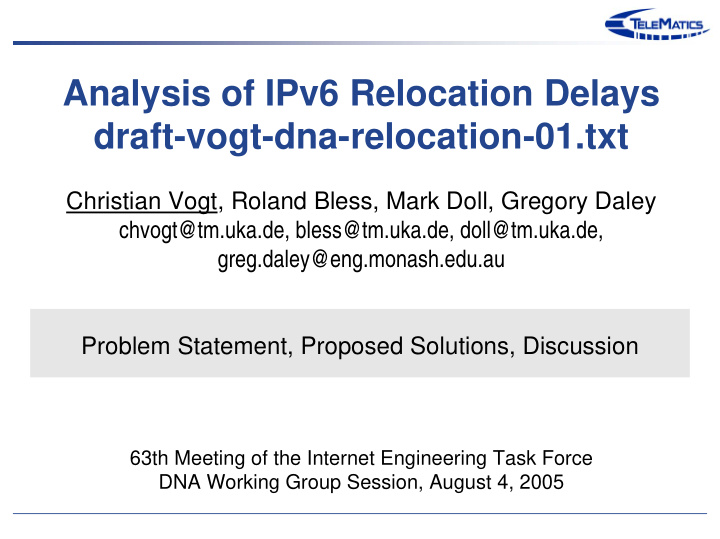



Analysis of IPv6 Relocation Delays draft-vogt-dna-relocation-01.txt Christian Vogt, Roland Bless, Mark Doll, Gregory Daley chvogt@tm.uka.de, bless@tm.uka.de, doll@tm.uka.de, greg.daley@eng.monash.edu.au Problem Statement, Proposed Solutions, Discussion 63th Meeting of the Internet Engineering Task Force DNA Working Group Session, August 4, 2005 Christian Vogt, Institute of Telematics, University of Karlsruhe, Germany 1
What are We Looking at? When a mobile node undergoes L2 handover… � Mobile node determines whether it changed IP attachment � This involves router discovery � Mobile node configures new addresses in case IP attachment changed This should be fast Christian Vogt, Institute of Telematics, University of Karlsruhe, Germany 2
How This Should Look Like Access Router Mobile Node Local Link L2 Handover Make LL addr. optimist. Rtr Sol (TSLLAO) Home Agent Rtr Adv Correspondent Node IP re-attachment! New optimist. global addr. MIPv6 Binding Update Ngb Sol (ODAD) … Christian Vogt, Institute of Telematics, University of Karlsruhe, Germany 3
So What's the Problem? � Optimistic addresses require prior transmission of an NS � Sending NS requires prior transmission of an MLD Report � MLD Report "SHOULD" be randomly delayed by up to 1 second when sent during interface initialization [RFC 2461/62 bis] � Objective of delays: de-synchronize simultaneous boot-up of multiple hosts � But: prevents fast IP re-attachment (and detection of it) Christian Vogt, Institute of Telematics, University of Karlsruhe, Germany 4
How It Really Looks Like Access Router Mobile Node Local Link L2 Handover Make LL addr. optimist. De-synchronization delay (0..1000ms) MLD Report Ngb Sol (ODAD) Rtr Sol (TSLLAO) Home Agent Correspondent Node Rtr Adv IP re-attachment! New optimist. global addr. MIPv6 Binding Update Christian Vogt, Institute of Telematics, University of Karlsruhe, Germany 5
Proposed Solutions Omit delay for initial MLD Report upon movement � De-synchronization delay is tailored to stationary scenarios � Mobility introduces inherent "natural" de-synchronization � Omit delay when mobile node receives L2 trigger indicating that an interface, which was operational, went down and came up again Start using optimistic addresses before initial NS � No technical reason why initial NS must be sent first Adding Robustness: Retransmit MLD Report and NSs � Both MLD and ODAD are unreliable since messages may get lost � Multiple MLD Reports and NSs increase robustness Christian Vogt, Institute of Telematics, University of Karlsruhe, Germany 6
This is How it Would Look Like Access Router Mobile Node Local Link L2 Handover Make LL addr. optimist. Home Agent Rtr Sol (TSLLAO) Correspondent Node Rtr Adv IP re-attachment! New optimist. global addr. MIPv6 Binding Update MLD Report Ngb Sol (ODAD) … MLD Report Ngb Sol (ODAD) … Christian Vogt, Institute of Telematics, University of Karlsruhe, Germany 7
Conclusions � Problem statement � Current IPv6 Autoconfiguration procedures prevent efficient detection of IP re-attachment due to de-synchronization delays � One scenario where this is problematic has been shown � More problematic scenarios in draft-vogt-dna-relocation-01.txt, with and w/o TSLLAO, with and w/o RS � Proposed solutions � Omit delay for MLD Reports upon movement � Start using optimistic addresses prior to initial NS (modification to draft-ietf-ipv6-optimistic-dad-05.txt) � Retransmit MLD Reports and NSs for robustness Christian Vogt, Institute of Telematics, University of Karlsruhe, Germany 8
Recommend
More recommend